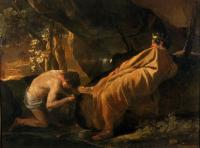Thursday, May 10, 2012 -  Carabinieri Art Squad,Caravaggio,FBI Art Crime Squad,Interpol,Nativity,Palermo,Sicily,stolen art database
Carabinieri Art Squad,Caravaggio,FBI Art Crime Squad,Interpol,Nativity,Palermo,Sicily,stolen art database
 No comments
No comments
 Carabinieri Art Squad,Caravaggio,FBI Art Crime Squad,Interpol,Nativity,Palermo,Sicily,stolen art database
Carabinieri Art Squad,Caravaggio,FBI Art Crime Squad,Interpol,Nativity,Palermo,Sicily,stolen art database
 No comments
No comments
More confirmation of old news? Pietro Grasso, head of the anti-Mafia crime unit, confirms in May that Caravaggio's Nativity of Palermo eaten by pigs
 |
| Caravaggio's Nativity from Palermo |
In 2009, Judith Harris wrote for the ARCA blog a post titled "Breaking News on the Stolen Caravaggio Nativity" that a member of the mafia told law officials that the painting was likely destroyed in the 1980s. But just last week, Journalist Noel Grima for The Malta Independent online reported May 6th that Pietro Grasso, the head of the anti-Mafia crime unit, confirmed again that legal authorities believe that the Caravaggio of Palermo has been eaten by pigs.
Possibly no one wants to believe that the painting has been so carelessly destroyed; the FBI and Interpol still list the painting as stolen and missing.
Possibly no one wants to believe that the painting has been so carelessly destroyed; the FBI and Interpol still list the painting as stolen and missing.
Grima repeats a formerly published article in eosarte.eu "Arezzo, il Procuratore antimafia Pietro Grasso: il Caravaggio di Palermo mangiato dai porci" dated April 22 reports that Grasso confirmed during a press conference earlier rumors that the Nativity paintings with Saints Lorenzo and Francis of Assisi has likely been tossed around by criminals and ended up in a pig sty and eaten by rats and pigs over the years.
"Ci verrobbe tempo perché è una lunga storia ... ma riteniamo che il quadro sia finito nelle mani di ignoranti che l'hanno hascosto in una porcilaia, dove magari porci poi se lo sono mangiato."
Grima translates:
The anti-Mafia's head's reply was a chilling one: "We need more time because the situation is rather complicated, but we believe the painting ended up in the hands of ignorant people who hit it in a pigsty where the pigs ate it."
The Malta connected dates back to the 17th century when the artist was imprisoned there. Caravaggio himself lead a tumultuous lifestyle documented in Italian police records.
Grima claims that a painting similar to The "Nativity" by Caravaggio would be worth $200 million while the FBI website estimates the value at $20 million.
In October 1969, two thieves entered the Oratory of San Lorenzo in Palmero, Italy, according to the FBI, and removed Caravaggio's Nativity with San Lorenzo and San Francesco from its frame.
Interpol still reports the painting as missing on its stolen art database and places the date of the theft as October 18, 1969. Interpol lists nine other works by Caravaggio (or from the school of or in the manner of) as stolen: Portrait of an Old Woman, Montepulciano, Italy, December 22, 1970; Doubting Tomas from Frascati, Italy, March 15, 1974; Beggars and Invalids (copper painting) from San Sebastian, Spain, April 1978; Man with a Pendant Earring, The Draughts Players, and Venice Feeding the Cupids, from La Storta, Italy, December 1, 1979; Saint Gerolamo, from Dozza, Italy, June 4, 1985; Two Men Playing Dice, from Lessona, Italy, July 27, 1986; and Los Jugadores from Santa Fe de Bogata, Colombia, October 24, 1999.









